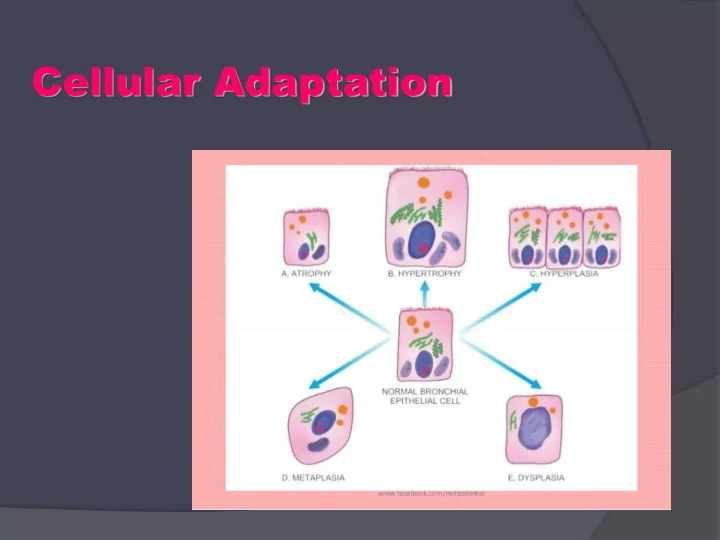

Cellular Adaptation
The very best way for most minds to remember, or identify, or understand a disease is to associate it with a morphologic IMAGE. This can be gross, electron microscopic, light microscopic, radiologic, or molecular. In MOST cases it is at the LIGHT MICROSCOPIC LEVEL .
The cell is the fundamental unit of disease
CELLULAR ADAPTATION : The ability of cells to respond to various types of stimuli and adverse environmental changes. The cell changes chat occur are: Atrophy (reduction in size and cell number) Hypertrophy (enlargement of individual cells) Hyperplasia, (increase in cell number) Metaplasia (transformation from one type of epithelium to another) Dysplasia (disordered growth of cells) Anaplasia,,,, Neoplasia.
Cellular Changes Then anaplasia/neoplasia
HYPERPLASIA Basic description: Increase in the number of cells. Types of hyperplasia Physiologic hyperplasia: Occurs due to a normal stressor. For example, increase in the size of the breasts during pregnancy, increase in thickness of endometrium during menstrual cycle, and liver growth after partial resection. Pathologic hyperplasia: Occurs due to an abnormal stressor. proliferation of endometrium due to prolonged estrogen stimulus. Important point regarding hyperplasia: Only cells that can divide will undergo hyperplasia; therefore, hyperplasia of the myocytes in the heart and neurons in the brain does not occur.
1- FOL LICULAR HYPERPLASIA (LYMPH NODE) 2- FOLLICULAR HYPERLASIA (TONSIL) 3- SINUS HYPERPLASIA (LYMPH NODE)
LYMP MPH H NODE DE
- FOL LICULAR HYPERPLASIA (LYMPH NODE) - ةفلتخم موجحب ةبرجلؤا نوكتو ،اهمجحو ،ةبرجلؤا ددع ةدايز . - بارجلا مظعم لمشيل جوتنلا زكرم ةماخض . - ةبرجلؤا مّخضتل ةجيتن ةظفحملا تحت بويجلا لوزت . - ،بللا ىّتح لصتو رشقلا زواجتت ثيح ةدقعلا مظعم ةبرجلؤا حاتجت ةظفحملا زواجتت لب اهّنكلو .
2- FOL OLLICULAR ICULAR HYP YPERLASIA ERLASIA (TON ONSIL) SIL) ةزوللا يف يبارج عنصت طرف ةدقعلا فلبخب كلذو ،ةزوللا يّطغت ةنّرقتم ريغ ةيطاخم ةقّبطم ةيفصر ٌةرشب يفيللا جيسنلا نم ةظفحم اهب طيحت يتلا ةيوافمللا ( ةزيمم ةملبع يهو ، ) ةيوناثو ةيلوأ ًاراوغأ ًةنّوكم قمعلل حطسلا نم تادامغنا ةرشبلا هذه يدبت جوتن زكرم تاذو ،ريبك اهمجح عّنصتلا ةطرفم ةيفمللا ةبرجلؤا ىرن ةرشبلا تحت مخض ةيباعل ددغ نم ءزج رّضحملا يف ىرن نأ نكمملا نم
.
SINUS HYPERPLASIA (LYMPH NODE ) ةيفمللا ةدقعلا يف يبيج عّنصت طرف ىلإ يّدؤي كلذو ةيبللا ًاصوصخو ةيفمللا ةدقعلا يف بويجلا عّسوت ظحلبنو ةبرجلؤا رمضت ام ًابلاغ كلذلو رشقلا باسح ىلع بللا مخضت اهضعبل اياقب . ةظفحملا لوح محشلاو ةيفيللا ةظفحملا . رشقلا : ،لب وأ ةرماض نوكت دق يتلا ةيفمللا ةبرجلؤا ضعب هيف دهاشي ًاضيأ مخضتت امبرو . بللا : علابلا ايلبخلاب ئلتمتو ةيفمللاو ةيديرولا بويجلا عّسوتت ثيح ة ةيمزلببلاو ةيفمللاو
HYPERTROPHY Increase in the size of the cell. Types of hypertrophy Physiologic hypertrophy: Occurs due to a normal stressor. For example, enlargement of skeletal muscle with exercise. Pathologic hypertrophy: Occurs due to an abnormal stressor. For example, increase in the size of the heart due to aortic stenosis. Morphology of hyperplasia and hypertrophy: Both hyperplasia and hypertrophy result in an increase in organ size; therefore, both cannot always be distinguished grossly, and microscopic examination is required to distinguish the two
ATROPHY • Atrophy is the shrinkage in cell size by loss of cellular substance • With the involvement of a sufficient number of cells, an entire organ can become atrophic • Causes of atrophy include decreased workload, pressure, diminished blood supply or nutrition, loss of endocrine stimulation, and aging • Mechanisms of atrophy : Apoptosis..Autophagy..
1- Fatty changes,,fatty degenration,,,lymph node. 2- Fatty changes … degenration … thymus.
ةيفمللا ةدقعلا يف يمحش عجارت ةظفحملا جراخ يأ ةدقعلا جراخ ةيمحش ايلبخ ظحلبن نأ يعيبطلا نم ةيفيللا ( يوس لكشب ) ةحضاو ةيمحش ايلبخ ترهظ لاح يف نكلو ثودح ىلع لدي اذهف ةيفمللا ةدقعلل يولخلا ميشناربلا نمض دودحلا ةيفمللا ةدقعلا هذه يف يمحش عجارت ةرماضلا ةيفمللا ةبرجلؤا ضعب هيف رشق . ةيفمللا ةدقعلا وزغي يمحش جيسن .
Histologic Features of the Thymus The cortex is composed primarily of lymphocytes(thymocytes), with a few epithelial and mesenchymal Cells , whereas the medulla is composed of more epithelial cells but fewer lymphocytes. Hassall corpuscles are the characteristic, round, keratinized formations with mature epithelial cells.
سومياتلا يف يمحش عجارت جيسنلا اياقبو يمحش جيسنو ماض جيسن يفمللاو يورشبلا . يهو بللا يف ةدوجوم لاساه تاميسج اياقب حئافص نم ةنّوكم ةنّرقتم ةيولخ ريغ ىنب ربتعيو ،ينيزويأ نولب رهظت زكرملا ةدحّتم ةمّلبعلا ةطقنلا لاساه ميسج
METAPLASIA REVERSIBLE change in which one mature/adult cell type (epithelial or mesenchymal) is replaced by another mature cell type A protective mechanism rather than a premalignant change Physiological metaplasia: cervical ectopy Pathological metaplasia Occurs as a response to chronic chemical or physical stimuli May completely regress or lead to malignant transformation (considered precancerous) Examples Intestinal metaplasia (Barrett metaplasia) Squamous metaplasia of the bronchi due to smoking → ciliated pseudostratified columnar epithelium is replaced by stratified squamous epithelium Squamous metaplasia of the bladder due to Schistosoma infection, urinary calculi, or indwelling catheters
Stratifiied squamous cells Ciliated columnar cells
ةيسفنت ةراهظ . . 1 . 2ةيكيبلام ةراهظ . . 3يوحت ةيطاخم تحت ةقبط ددغو وخر ماض جيسن . . 4يفورضغ جيسن
Barrett ’ s Esophagus Intestinal Metaplasia of the Esophagus
THANK YOU
Recommend
More recommend